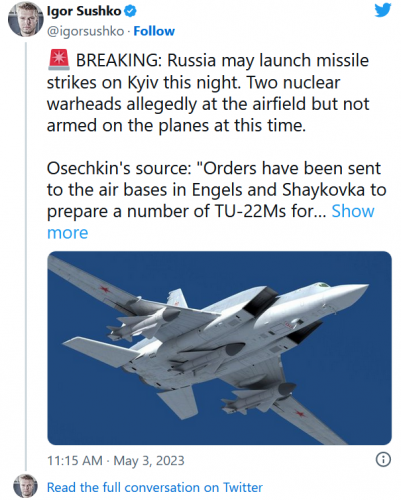Despite ongoing tensions and nuclear talk from Russian officials, the constant fear of a Russian nuclear strike is currently unwarranted; nevertheless, there are several warning signs that could indicate Russia is preparing to use nuclear weapons you should watch for.
Russia’s nuclear arsenal has long been considered a crucial element of its defence strategy, with officials emphasizing that using nuclear weapons is a last resort and primarily in response to a nuclear attack on Russia or its allies. However, recent developments within Russia since the invasion of Ukraine began, have loosened the restrictions Vladimir Putin has on using his nuclear arsenal.
An increase in military activity and exercises is one of the significant warning signs that Russia may be preparing to use nuclear weapons. This could involve additional troops mobilization, heightened activity from aircraft and naval vessels, or drills focused on nuclear warfare or tests of their nuclear deterrent capabilities. This may be hard to differentiate due to the ongoing war in Ukraine, but it would be characterized as large growth in activity in regions bordering other countries Russia considers to be adversaries. Such activities could be evident in Russia’s western regions, which border with NATO countries.
Russia may increase alert levels for its military forces, such as placing strategic assets on higher readiness, conducting exercises designed to simulate a nuclear conflict or pre-delegation of launch authority to commanders in the field. Higher alert levels are a clear signal that a country is taking the possibility of conflict seriously, particularly with regard to nuclear weapons, which require careful coordination and planning.
Strategic redeployment of forces is another warning sign that Russia may be preparing to use nuclear weapons. This could involve moving military assets closer to potential targets, deploying additional forces to key locations or positioning weapons systems in a more aggressive posture. For example, it could mean deploying more troops, artillery, and armoured vehicles to the Baltic region.
Russia may increase propaganda and rhetoric justifying the use of nuclear weapons. Statements from Russian officials or state media that emphasize the importance of Russia’s nuclear arsenal or suggest that Russia is being threatened by external actors are examples of this. For instance, the Russian media might suggest that Russia needs to use its nuclear weapons to counter an aggressive stance by NATO. It could also be smaller things like local governments warning their people about the possibility of nuclear war, where shelters are and instructions for surviving.
This has been seen already, with Russian state media beginning to share views of nukes being important for Russia’s survival and that they are okay to use if Russia is at existential risk. The rhetoric that Russia is actually at war with NATO and not only Ukraine builds the image of the nation being left with no choice but to use nukes in the face of destruction by Western states in the eyes of their people.
Another sign could be an increase in cyber attacks and disinformation campaigns that suggest Russia is preparing to use nuclear weapons. They could target critical infrastructure, such as nuclear power plants or electric grids to create instability in foreign countries. For example, they could spread false information about a nuclear attack to cause panic within NATO. There is also the possibility of physical attacks against cyber infrastructure such as the trans-Atlantic cables between North America and Europe which are responsible for handling $10 trillion (USD) in transactions every day.
It is crucial to note that the presence of one or more of these warning signs does not necessarily mean that a nuclear strike is imminent, and most experts believe that the chances of a nuclear war breaking out are currently low.
If you see social media posts mentioning rumours or unconfirmed reports of Russian nuclear weapons preparing to be used, make sure you read the warning signs above. If a significant portion is not present then you can safely assume it’s either Russian disinformation or malicious rumours meant to scare people or grow someone’s influence.

One such example of wildly inaccurate and inflammatory rumours that spread from Twitter. Important to note the plane the author alleges is going to deliver a nuclear missile is not capable of carrying the reported missile.
It is also extremely likely that any sudden changes in Russian force disposition at both the nuclear and force level will be immediately known about by hundreds of intelligence agencies and OSINT volunteers around the globe. Russia often uses open communication channels which people can listen to with the right equipment. Things like this will be reported within hours of it happening and the government will be quick to make it known to the public. Messages from Washington, Brussels and other capitals would be rapid in their condemnation and calls for Russia to back down.
In conclusion, while the threat of a nuclear conflict is always a concern, it is essential to understand the signs that would indicate that Russia may be preparing to use nuclear weapons. By closely monitoring changes in Russia’s military posture, you can stay prepared. You should always have at least 72 hours worth of food and clean water prepared for emergencies of any kind.
